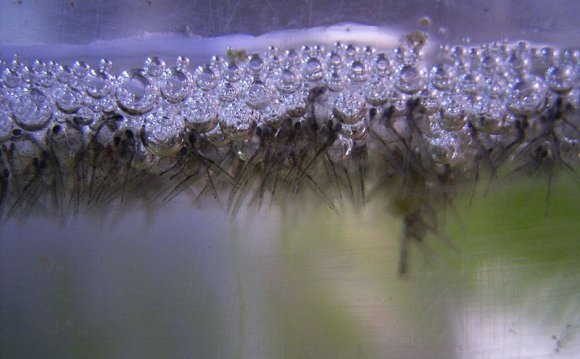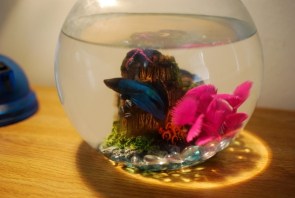
 Betta fish are popular pets for fish lovers who are anywhere from inexperienced beginners to experts. Though you may have seen their beautiful colors and flowing tails, you might not know about the amazing history behind the betta fish or the best betta fish food.
Betta fish are popular pets for fish lovers who are anywhere from inexperienced beginners to experts. Though you may have seen their beautiful colors and flowing tails, you might not know about the amazing history behind the betta fish or the best betta fish food.
History of the Betta Fish
The history of the betta fish is a feisty one. They were first known as Siamese fighting fish, found in the wild in Vietnam. The wild versions are not as eye-catching as the ones you see in pet stores. Wild bettas show little to no coloration, favoring blacks and browns, and have short fins—they basically don’t look anything alike. The colors and long fins were traits that were bred for over decades.
Instead, the betta’s popularity came from their aggressive nature. People caught them and watched them fight, even betting on them for sport. The winner was determined by the fish that continued to fight the longest. The Vietnamese king in the 1830s decided he liked the sport, so he sent out a team to catch, breed, and fight them under royal supervision.
Later, a few of the fighting fish were given to a scientist who gave them their new name. Then they spread to a French aquarium that made them popular for their colors.
Today male bettas are popular as pets because they are fairly easy to keep alive and they are beautiful. Their long, flowing fins and bright colors look stunning in otherwise boring spaces.
Betta fish have relatively short life spans, living about 2 to 4 years in captivity, though some have been known to live as long as 10 years under good circumstances. During their lives, adult bettas can grow up to 7 centimeters long. Their fins can be considerably longer depending on the variety of betta and its living conditions.
Years of evolution and breeding have given the betta some interesting ways of survival. For example, betta fish can breathe through gills underwater or with their mouths above water from their time spent in rice paddies. When the rice paddies were drained each year, the bettas would have to live by spending time in the mud and breathing with their mouths until the rains came again.
Bettas also have peculiar parenting skills. Before mating, male bettas create a bubble nest with their mouths to house the eggs. Then, after the eggs have been deposited and fertilized, the male takes over protection of the nest. This is vital for the species because female bettas have a habit of eating their eggs.
Today, pet betta fish have over 14 different fin varieties and come in a rainbow of colors. You can find betta fish that are red, orange, yellow, blue, steel blue, turquoise/green, black, pastel, and white. Many bettas are even multiple colors.
How to Take Care of a Betta Fish
If you are a new betta fish owner or are thinking about getting a Siamese fighting fish, here are the steps to keeping your betta happy and healthy.
1. Set up an aquarium—Make sure the tank is not too small, bigger that two gallons, and solitary from other fish. Bettas will fight other fish of its kind and fish with flowing fins that can be mistaken for a betta. They are aggressive because they are territorial. However, some betta fish can be put in community tanks with types of tetras, guppies, and bottom feeding fish. Make sure you check with fish experts and research before you get possible aquarium mates.
2. Provide hiding places—Betta fish love to hide and have something to provide variety in their tanks. Hiding places also help bettas to feel safe.
3. Get betta fish food—There are many betta fish foods available in stores and online. Betta fish food flakes or pellets like betta fish food frenzy flakes is the best food for betta fish because it has been formulated to keep bettas healthy with bright colors. For more on feeding betta fish, see the commonly asked questions below.
4. Keep the water clean—Change the water in your tank often. It should have a filtration system and be monitored carefully to keep your fish happy. If you don’t use a filter, the water needs to be changed multiple times a week. Water in a betta tank should have a slightly acidic pH between 6.5 and 7. You should test the water weekly with pH strips available at pet stores.
5. Keep water warm—Betta fish prefer a warm environment between 76 and 82 degrees. This can be accomplished with a tank heater or you can place the tank near a radiator or other heat source. Make sure the tank isn’t too close to the heat source or else you may risk the water getting too warm.
6. Play with your betta fish—Yes, they betta fish can actually play. They have memories up to 3 months long, so you can teach them to follow your finger or play little games.
Common Feeding Questions:
Q: What do betta fish eat? What can you feed betta fish?
A: In the wild, Siamese fighting fish might eat zooplankton, little crabs, snails, mosquito larvae, and other water-bound insects. In captivity, they should eat betta fish flakes or another specially formulated food. Look for pellets or flakes that contain at least 40% protein and have protein sources as the first three ingredients.
Q: Can you feed betta fish tropical fish food?
A: Betta food is made specifically for bettas. Though tropical fish food might not hurt a betta, it won’t provide the right balance of nutrients for a healthy, colorful betta like fish food for bettas will.
Q: How do you feed a betta fish?
A: Bettas have upward-facing mouths that allow them to eat things on the surface of the water easily. Sprinkle a few fish flakes on the water in the tank and let your betta eat what he wants.
How often do I feed my betta fish?
A: Your betta will eat when he’s hungry. Usually, bettas are happy to be fed once a day. If there is food remaining in the tank after the fish is done, remove it to keep the tank clean.
Q: What do I feed baby betta fish?
A: Raising baby betta fish is a delicate job. What to feed baby betta fish depends on their age and size. Betta fish baby food can be found in stores, or you can feed them cooked egg yolks for the first few days. Betta baby fish need different food than adult bettas because they can’t eat such large food. Research baby betta needs for more information.
Where to Buy Betta Fish Food
The best food for betta fish is HBH Betta Bites available in some small pet stores and online from Pisces Pros. You can find bulk betta fish food and wholesale betta fish food, along with other HBH products, based on your needs.
Feeding a betta fish is easy with a few shakes of your betta fish’s favorite food, HBH Betta Bites. You can get betta fish food, spirulina fish food, and hermit crab food from Pisces Pros. Visit Picespros.com or contact us to order.









